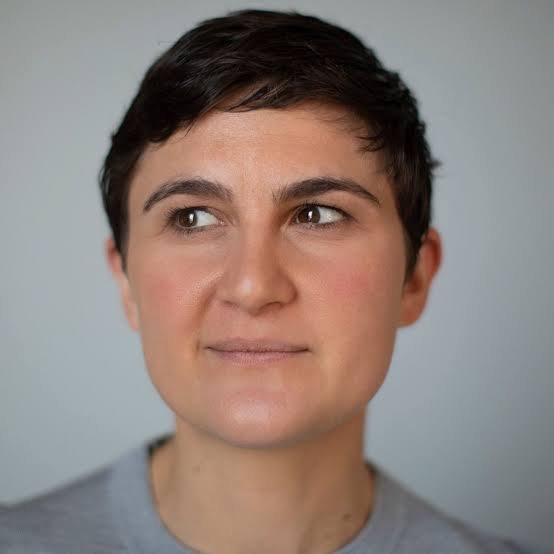Leilehua Lanzilotti
Leilehua Lanzilotti (b. 1983) is a Kanaka Maoli (Native Hawaiian) composer / sound artist dedicated to the arts of our time. A "leading composer-performer" (The New York Times), Lanzilotti’s work is characterized by explorations of timbre and an interest in translating everyday sounds to concert instruments using nontraditional techniques. Her musical voice is grounded in experimental practices, both through influences as part of the network of musicians / artists in the Wandelweiser collective, and her own explorations into radical indigenous contemporaneity.
Lanzilotti was honored to be a finalist for the 2022 Pulitzer Prize in Music for her string orchestra piece, with eyes the color of time, which the Pulitzer committee called, “a vibrant composition . . . that distinctly combines experimental string textures and episodes of melting lyricism.”
Previous honors include the 2021 McKnight Visiting Composer with the American Composers Forum, a MAP Fund grant for [Switch~ Ensemble] for development and performance of hānau ka ua, a National Performance Network Creation & Development Fund grant for ahupuaʻa, a Native Launchpad Artist Award, an OPERA America: Women Composers Discovery Grant, the New World Symphony BLUE (Build, Learn, Understand and Experiment) Alumni Award, a Bogliasco Foundation Fellowship, an Empowering ʻŌiwi Leadership Award (E OLA), and a First Peoples Fund Artist in Business Leadership Fellow among other accolades.
As a composer, Lanzilotti’s works have been performed at international festivals such as Ars Electronica (Austria), Thailand International Composition Festival, and Dots+Loops—Australia's post-genre music and arts series. She has written for ensembles such as Roomful of Teeth, Argus Quartet, ETHEL (with guest Allison Logins-Hull), [Switch~ Ensemble], the Borderlands Ensemble, Chamber Music Hawaiʻi, and Longleash. She has written for soloists such as James Austin Smith, Melia Watras, and Rachel Lee Priday.
Lanzilotti has collaborated with The Noguchi Museum on several commissions, writing compositions honoring Noguchi sculptures in conjunction with installations. These projects include birth, death (2017), for Noguchi’s obsidian Sounding Stones and ensemble; Postcards II: Akari (2018), for flute, viola, harp (or guitar), and fixed media based on the sounds of Akari; and beyond the accident of time (2019), for percussion and voices, inspired by Noguchi’s never-fully-realized Bell Tower for Hiroshima (1951). A text version of this score is included in Walking From Scores, a bilingual anthology of text and graphic scores to be used while walking, from Fluxus to the critical works of current artists, through the tradition of experimental music and performance, gathered and presented by Elena Biserna. “Lanzilotti’s score brings us together across the world in remembrance, through the commitment of shared sonic gestures.” (Cities & Health) A new work project in collaboration with The Noguchi Museum and the Toshiko Takaezu Foundation will include a concert program of new works and interactive installation piece for an upcoming national tour.
As a recording artist, Lanzilotti has played on albums from Björk's Vulnicura Live and Joan Osborne's Love and Hate, to Dai Fujikura's Chance Monsoon and David Lang’s anatomy theater. Lanzilotti has premiered many new works including Wayfinder—a viola concerto by Dai Fujikura inspired by Polynesian wayfinding. in manus tuas—Lanzilotti’s solo viola album debut—was featured in Steve Smith’s Log Journal Playlist (Live life out Loud), Bandcamp’s Best Contemporary Classical Albums of 2019, and The Boston Globe’s Top 10 classical albums of 2019, and was called “an entrancing new album” by The New Yorker’s Alex Ross.
To reach new audiences and share contemporary music, Lanzilotti has published articles in Music & Literature and Neue Zeitschrift für Musik, and written program notes for the London Symphony Orchestra and liner notes for Kaija Saariaho / Jennifer Koh among others. Lanzilotti's dissertation is an analysis of Andrew Norman’s The Companion Guide to Rome showing the influence of architecture and visual art on the work. As an extension of the research, she created Shaken Not Stuttered, a free online resource demonstrating extended techniques for strings. Upcoming written publications include contributions to a new monograph honoring the life and work of Toshiko Takaezu to be published by Yale University Press, and to Tuning Calder’s Clouds, edited by Vic Brooks and Jennifer Burris, which will be published in fall 2022 in a collaboration between the Calder Foundation and Athénée Press. It is the first book to explore the artistic, technological, and political intersections of Alexander Calder’s sculptural Acoustic Ceiling.
As an educator, Lanzilotti has been on the faculty at Casalmaggiore International Music Festival, Point CounterPoint Music Festival, New York University (where she started and developed the curriculum for the extended techniques for strings and performing with electronics courses), University of Northern Colorado (where she was Director and founder of the experimental UNCOmmon Ensemble and Asst. Professor of Viola), and University of Hawaiʻi—Mānoa in both composition and viola.
Dr. Lanzilotti studied at Oberlin Conservatory of Music, Yale School of Music, and Manhattan School of Music. In addition, Lanzilotti was an orchestral fellow in the Rundfunk-Sinfonieorchester Berlin and New World Symphony. She participated in the Lucerne Festival Academy under Pierre Boulez, and was the original violist in the Lucerne Festival Alumni Ensemble. Her mentors include Hiroko Primrose, Peter Slowik, Jesse Levine, Martin Bresnick, Wilfried Strehle, Karen Ritscher, and Reiko Füting.
Pronunciation: Leilehua
